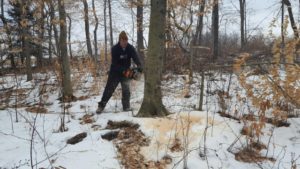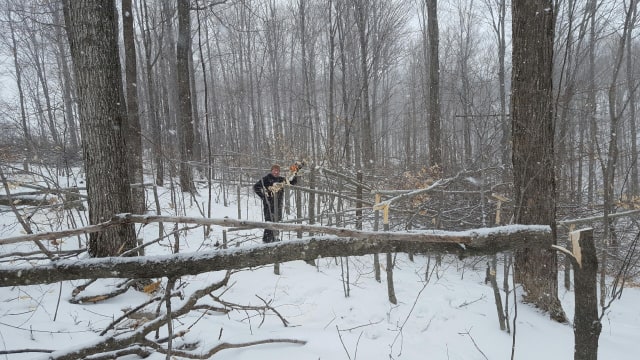Often, when winter rolls around, our minds tend to focus on turkey hunting and food plots and stray from whitetails. However, winter is the best time to scout and plan for the next fall hunting season. Winter is a great time to monitor trail systems on your property and relocate stand locations that did not produce positive results. The white-tailed deer has developed a remarkable set of adaptations that enable the species to survive the deep snow and cold temperatures of harsh winters in the northern limit of their
range. Very few of us think about whitetails in the dead of winter. There are no fawns to be fawned over, no legal season for hunting besides looking for shed antlers, and only the occasional rare roadside sightings. Yet for the deer themselves, late winter is the season of desperation. The whitetail’s strategy for surviving winter is, quite simply, to wait it out. While other animals flee southward, hibernate in holes, or even freeze solidly (like the wood frog), whitetails hunker down and hope for the best.
Browse Cuts
Timber stand improvement (TSI) is an intermediate treatment in the regeneration of a forest stand. Treatments are made to improve the composition, structure, condition, health, and growth of a stand of timber. TSI practices can also be used to thin the forest stand by removing undesirable trees to favor more desirable trees, such as healthy oaks and hickories. This thinning produces numerous timber and wildlife benefits. By allowing more sunlight to reach the forest floor, it increases timber growth, stimulates forest regeneration, and promotes growth of deer browse forage. It also gives the remaining trees more room to grow, resulting in larger tree crowns and increased mast production.
Hinge cutting is the easiest and quickest way to create perfect whitetail habitat. The advantage of hinge cutting is it automatically creates food and cover and facilitates deer movements through specified corridors (browse ways). Some hinge cuts that are performed properly and maintained can still produce high-quality food and cover for up to ten years. Fertilizing and pruning of preferred whitetail browse species can greatly influence daytime activity in and around corridors. Whitetail deer are very selective in what browse species they consume, and by fertilizing such high-quality browse species, you will increase daytime usage in and around areas you have prepared for this.
Below is a short list of great browse species that top the whitetail’s diet and others that show signs of change.

Preferred Browse
White Cedar, Yew, Apple, Sassafras, Mountain Maple, Striped Maple
Red Maple, Witch Hobble, Flowering Dogwood, Alternate Leaved Dogwood, Basswood, Staghorn Sumac, Wintergreen
Readily Browse Species
White Ash, Sugar Maple, Oaks, Black Birch, Yellow Birch, Hickory, American Chestnut, Choke Cherry, Elm, Black Walnut, Raspberry and Blackberry, Lowbush Blueberry, Butternut, Green Ash, Hazelwood, Wild Grape, Bush Honeysuckle, Wild Apple
Starvation or Poor Browse Species
Scotch Pine, White Pine, Red Pine, Beech, Aspen/Poplar, Mountain Laurel, Rhododendron, Gray Birch, Paper Birch, Musclewood (Blue Beech) Ironwood, Spruces, Alder, Black Locust, Grey-Stemmed Dogwood, Red Cedar, Balsam, Raspberry and Blackberry, Pin Cherry, Honeysuckle, Tamarack, Gooseberry, Buckthorn, Hawthorn
Conclusion
One thing that must be kept in mind regarding winter browse of woody material is that the deer may eat something, but before it can be digested, the browse must be thawed. The energy used by the deer to do this detracts from their supply of energy needed to keep warm. This conveys the importance of effective thermal cover for whitetail survival in severe winters. The amount of energy a deer derives from eating browse must exceed the amount of energy needed to thaw the browse so that it can be digested. If it doesn’t, the deer will starve to death with a paunch full of food.



















![The Best Deer Camp Chili [VIDEO] Deer Chili Ingredients, Tomatoes, Chili Spices](/wp-content/uploads/2015/10/Deer-Chili-Deer-Camp-Recipe-218x150.jpg)
![How to Call Elk Early in the Season [VIDEO]](/wp-content/uploads/2016/08/byers003-218x150.jpg)




![Idiots Disturb Hunter: How Would You Have Handled It? [VIDEO]](/wp-content/uploads/2015/10/DSC00110-e1474487693878-100x70.jpg)
![Albino Buck Shocked to Shed His Antlers [VIDEO]](/wp-content/uploads/2015/10/AlbinoDeer-100x70.jpg)